In 1995 in his song CHILDHOOD, Michael Jackson asked: Have you seen my Childhood? And our answer is at the same time the exact problem: Yes. The public saw Michael Jackson’s childhood. He grew up on stage.
In 1991, Michael Jackson released his DANGEROUS album and, on that cover, children who spent their childhood in the entertainment industry end up in hell just as much as they do in Hollywood. And yet on DANGEROUS there is Michael Jackson’s guardian angel Shirley Temple watching out for the King of Pop.
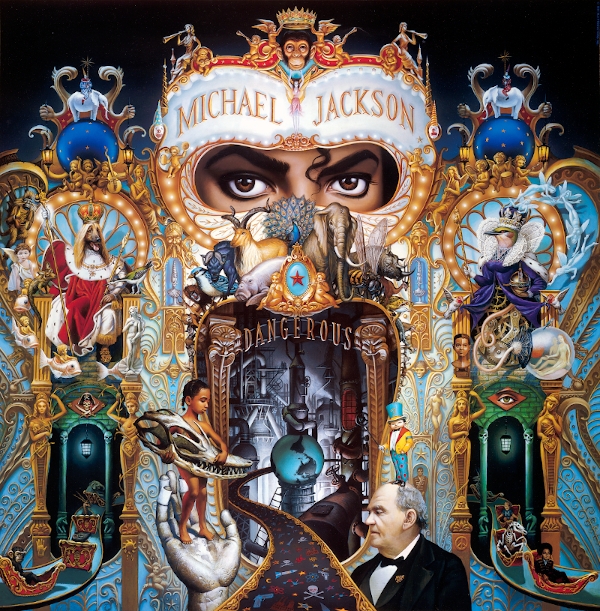
picture: Michael Jackson’s DANGEROUS album cover 1991, SONY Music Entertainment. Painter of the artwork named „King of Pop“ (acrylic on wood 82” x 74”) is Mark Ryden. The original of the painting is exhibited in the Paul Kasmin Gallery, 293 Tenth Ave., New York, NY 10001. source
„There were times, let me make that clear, when I’d come home from school and I’d only have time to put my books down and get ready for the studio. Once there, I’d sing until late at night, until it was past my bedtime, really. There was a park across the street from the Motown studio, and I can remember looking at those kids playing games. I’d just stare at them in wonder—I couldn’t imagine such freedom, such a carefree life—and wish more than anything that I had that kind of freedom, that I could walk away and be like them. So there were sad moments in my childhood. It’s true for any child star. […]
Michael Jackson, Autobiography MOONWALK. Random House. Kindle-Version.
When you’re young and you’re working, the world can seem awfully unfair. I wasn’t forced to be little Michael the lead singer—I did it and I loved it—but it was hard work. If we were doing an album, for example, we’d go off to the studio after school and I might or might not get a snack. Sometimes there just wasn’t time. I’d come home, exhausted, and it’d be eleven or twelve and past time to go to bed. So I very much identify with anyone who worked as a child. I know how they struggled; I know what they sacrificed.„
ENTRARE: Tunnel of Horror. Childhood, stars and Michael Jackson
On Michael Jackson’s DANGEROUS cover, the gondolas of the ghost train ride with the following cast: Bubbles and Ben. Michael’s brothers are not in the picture. source
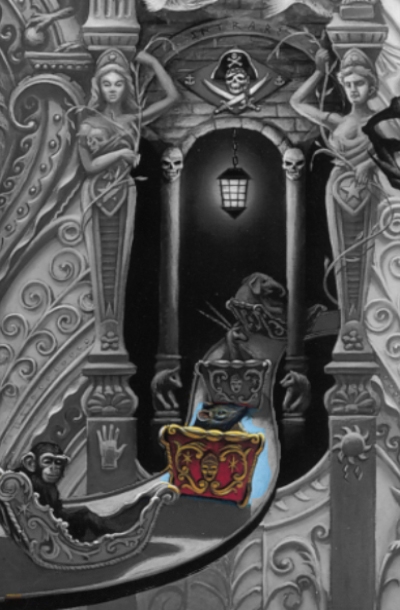
picture: Michael Jacksons DANGEROUS Cover 1991: a chimpanzee, a rat … source
Bubbles
Bubbles, a young chimpanzee, child star of his own kind. Achieved world fame at Jackson’s side. In 1986, Bubbles even made it into the movies. Bubbles was Jacksons chimpanzee and born in 1983 in an experimental laboratory. The chimpanzee was 8 months old when Jackson adopted him. At the side of the King of Pop, Bubbles became famous, and Jackson took him to press conferences in Japan. During these events, the chimpanzee sat on a chair at the table, was wearing clothes and drank tea, while Jackson kept him under control with sign language. Mayors and press people had to accept the chimp at these formal receptions (which were by no means Jackson’s liking). Bubbles probably lived less with Jackson than with his trainer and still lives today (2023). In 1988, Jackson immortalized Bubbles and gave him a cameo in the musical film LEAVE ME ALONE.
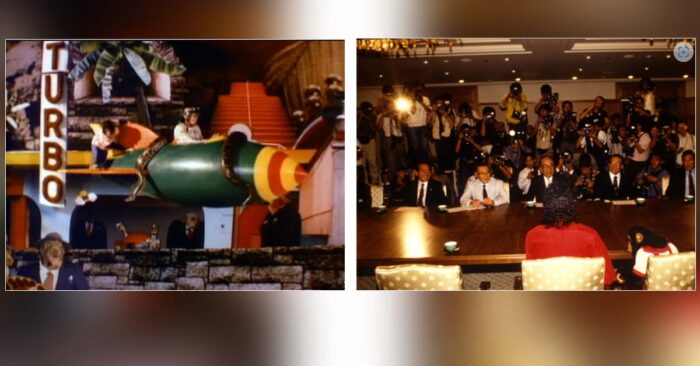
picture: Michael Jackson 1988 LEAVE ME ALONE with Bubbles and at a press conference in Japan. Bubbles the chimpanzee is sitting at the table.
Ben
Ben, the rat. Ben is an imaginary friend from 1972 and also a movie star. It was Michael, the child star, who in 1972 sang about Ben, the movie star. In a horror movie. The movie from 1972 is titled „BEN, where ‚WILLAR‘ ended BEN begins. And this time, he’s not alone!“. This was a horror film about the friendship between a boy and a rat. The movie’s theme song BEN was sung by fourteen-year-old Michael Jackson and was his first Number-One-Single as a solo performer. Ben was a milestone in Michael Jackson’s solo career. The song was his first number one, got an Oscar nomination and won a Golden Globe.
In the gondolas at the very front sits a small antelope, then a baby elephant.
Michael Jackson EXITUS childhood or survival of the fittest
For all passengers, it seems the journey ends in hell. The ride leads to this area, which on the DANGEROUS cover is labeled EXITUS. So who survived the showbusiness?
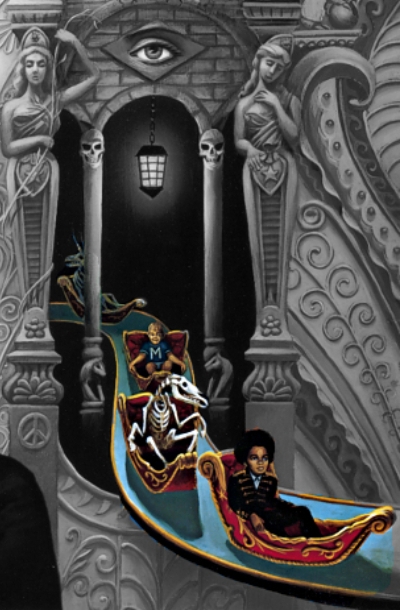
picture: Michael Jacksons DANGEROUS Cover 1991 with child star Michael Jackson, then comes a dead figure, followed by child star Macaulay Culkin, then comes another a dead figure. Is that the childhood of child stars? source
The boy Michael Jackson or „Have you seen my childhood?“
It seems, little Michael Jackson, who spent his entire childhood at work in the entertainment industry, remains unharmed. At least on the outside, because there is no smile on his face. But he wears military uniform and leads the procession of gondolas. Was the little boy a fighter? Or is this image symbolic for the child Michael who had survived in Jackson, the man? The man Michael Jackson who so compassionately remembered what it means to work his entire childhood in an industry. „Have You Seen My Childhood?“, Michael Jackson asked in 1995 1 and in the answer to his question we can find the problem: Yes. His childhood had been seen by everybody, because he had spent his life in front of the public on the stage.
Little Michael had prevailed. From antelope and elephant, however, only their bones are left.
Macaulay Culkin – We have seen his childhood too … home alone
Macaulay Culkin is the boy in the gondola on DANGEROUS with the „M“ on his shirt. He’s one of the few who survived Hollywood. Macaulay was a child star with worldwide fame in the 1990s („Home Alone“). He also suffered under his overambitious father, like Michael suffered under Joe Jackson.Macaulay is remembered by Michael in 2000:
„There is this precious sweet little soul who is a baby, Macaulay Culkin, who is wondering, ‚How did I get caught up in all of this? I never asked to be an actor.‘ He always wanted out.„
Michael Jackson about Macaulay Culkin. 2
Decades later, Macaulay Culkin remembered the physical and emotional abuse by his own father:
„He was a bad man. He was abusive, physically and mentally. I can show you all my scars if you want to. He was a bad dude.”
Macaulay Culkin, 2018. 3
Many child stars die young. Michael Jackson commented on that:
„Not a lot of them are left. That’s what is scary. Most of them self-destruct.“
Michael Jackson, around 2000. 4
Macaulay Culkin had survived, and the boy Michael became King.
Shirley Temple and Michael Jackson – Have you seen her childhood ….?
On the DANGEROUS album cover by Michael Jackson, he devoted a special place to the singer, dancer and actress Shirley Temple. Shirley Temple is a world-famous child star in film history since 1932. She was described as „the eighth wonder of the world“. In the end, she survived Hollywood. DANGEROUS portrays the child Shirley Temple. Shirley Temple is the angel at the side of the King of Pop. ( … not so hard to see.)
„It’s hard to see angels …„
Michael Jackson, 1992 in Angel of Light. 5
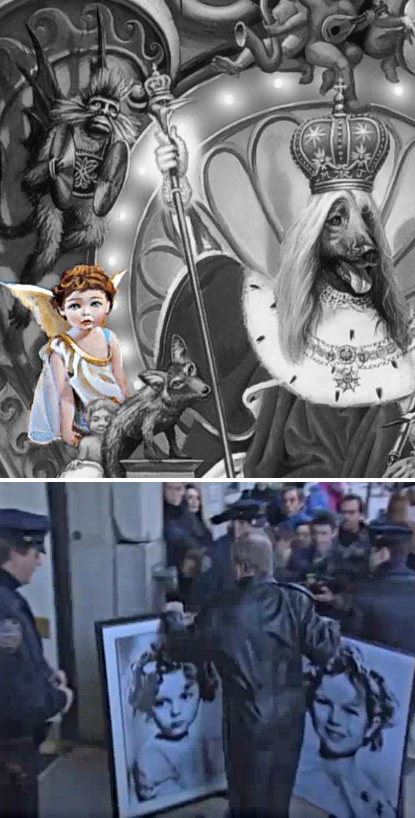
picture: In 1995 the portraits of Shirley Temple were brought into the hospital to Michael Jackson. picture source and report
„you’ve saved my life … I can survive this.“
Michael Jackson to Shirley Temple around 2000. 6
The sad little angel Shirley Temple is sitting next to KING MJ. This angel is close to Michael’s side; Shirley Temple, the child, was Michael Jackson’s guardian angel. She saved his life; Michael Jackson later personally explained this to the adult Shirley Temple.
„I went to her house. I left there feeling baptized, I really did. I didn’t know that I would break down crying when I saw her and I just broke down. I said, ‚You don’t know how you’ve saved my life.‘ She goes, ‚What do you mean?‘ I said, ‚So many times I have been at the end of my rope and I have felt like throwing in the towel and I just look at your picture and I feel there’s hope and I can survive this.’So many times I have been at the end of my rope and I have felt like throwing in the towel and I just look at your picture and I feel there’s hope and I can survive this.“
Michael Jackson, 2000. 7
As an adult, the surviving Shirley Temple turned her back on show business:
„She was appointed as a delegate to the 24th United Nations General Assembly[…] 1969) by President Richard M. Nixon and United States Ambassador to Ghana (December 6, 1974 – July 13, 1976) by President Gerald R. Ford. She was appointed first female Chief of Protocol of the United States (July 1, 1976 – January 21, 1977), and in charge of arrangements for President Jimmy Carter’s inauguration and inaugural ball.“
Source: Shirley Temple – Wikipedia
In 1995, Michael Jackson collapsed on stage under the pressure of an upcoming show to be broadcast worldwide. Jackson had to be hospitalized. Into the hospital his crew members brought him portraits of Shirley Temple, the child star. Michael Jackson was obviously at the end of his rope.
But what about the guardian angels?
„It’s hard to see angels, although I’ve stared at their pictures for hours. Some people can see them without pictures, and they tell interesting tales. Guardian angels are all female, for instance, which didn’t surprise me once I found out.“
Michael Jackson, 1992. 8
A „Flying Monkey“ or the father being his manager? The Childhood of child star Michael Jackson
Michael did not only on DANGEROUS had a demon behind him. There is a figure reminiscent of a „flying monkey“, one of the fantasy figures from his movie THE WIZ. The 1978 musical THE WIZ is another milestone in the King of Pop’s career. In THE WIZ, Michael played the role of the Scarecrow. In THE WIZ, the „Flying monkeys“ carried out the orders of the wicked witch.
„Following the description in the original book, the term „flying monkey“ was adopted in psychology to refer to someone who works on behalf of an abusive person to provide support. […] The term ‚flying monkey‘ has been used in psychology to refer to those helping an abusive person […]. It specifically refers to someone who works for the abuser, like the winged monkeys for the witch in the original book. The abuser usually uses family members, friends or co-workers who are loyal and/or obedient to him as flying monkeys to undermine or attack his goals.“
Winged monkeys – Wikipedia in Psychology.
The character in the role of the „flying monkey“ on the DANGEROUS cover has a particularly merciless expression on his face. He is particularly loud here, unapologetically setting the tempo. And then this look … is there a connection to Michael’s father Joe Jackson? The manager of Michael, the child star? Michael remembered:
„He’d be in the audience and he would make a face like this. He’d go [makes facial gesture] and it would scare the bejesus out of you and you’d think, ‚I can’t mess up. He’ll kill us.‘ Everybody would clap and he would be like, ‚We’re going to hit you hard. Don’t you mess up.‘ I’d be like, ‚God, I’m in trouble after the show.‘“
Michael Jackson around. 2000. 9
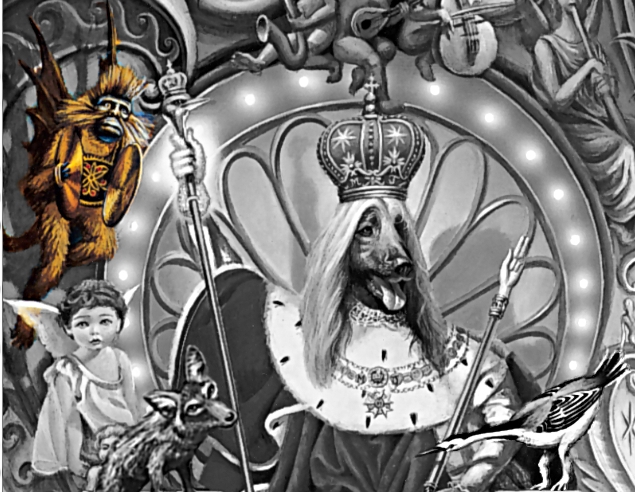
picture: Is there a connection between the demonic fantasy figure of the „flying monkey“ on DANGEROUS and the controlling, relentless manager in Michael Jackson’s childhood? Michael Jackson’s father Joseph Walter Jackson?
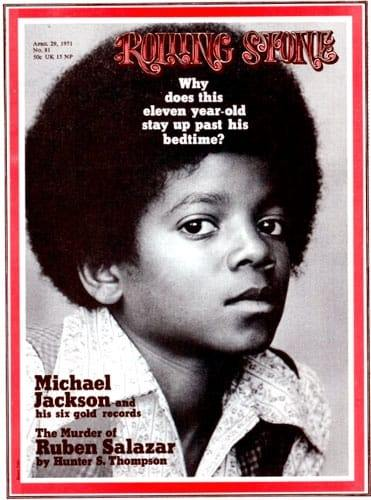
Picture: Michael Jackson on the cover of the music magazine „Rolling Stone“ in 1971. The kid Michael Jackson had worked at that time already night after night on stage for seven years. The magazine’s headline asked the question:
„Why does this eleven-year-old stay up past his bedtime?“
Laws regarding child work, prohibiting minors from working on stage at such a late hour, did not yet exist when little Michael was a child.
„Have you seen my childhood…?“
The childhood of little Michael Jackson or: „Kids At Work“
„One day on the bus I remember him saying „I wish I could write a book about the children of the world. I could go to every country and show how everyone on earth is beautiful. I want to go to India and show the poverty and suffering of the children there, and maybe I could help improve the situation. Africa, too, where there is so much starvation and disease. Todd, would you want to do that with me?“ I was stunned, both because I wondered how Michael would ever find the time and also that he wanted me to be the photographer. I suggested that he take a look at the photographs of Lewis Hine, the influential photojournalist whose work helped spur the introduction of child labor laws in the early twentieth century.“
Todd Gray, Michael Jacksons photographer in the years 1974-1983.
„We also looked at the work of the 19th century photographer Lewis Hine’s images of children slaving away in New York textile factories, their eyes lost and vacant. He was very touched by these images.“
Todd Gray, Michael Jacksons photographer in the years 1974-1983. 10
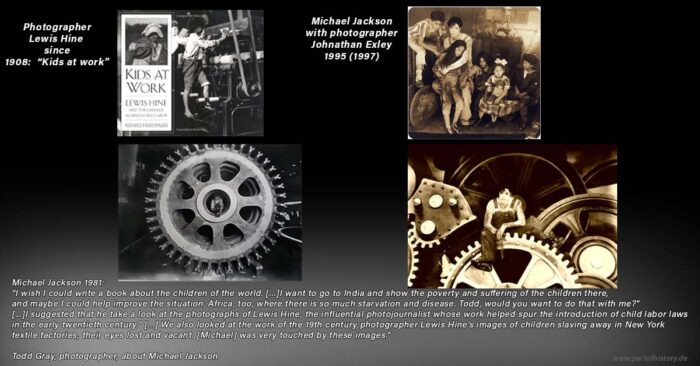
picture: book cover „Kids At Work“ with photos from Lewis Hine since the year 1908. The book is about exploitation of children by child labor. On the right Michael Jackson, who had spent his entire childhood working, in a 1995 photo session with Jonathan Exley (possibly as part of CHILDHOOD and SMILE promotion).
„to open the public’s eyes to the horrors of child labor.„
Author Russel Freedman about photographer Lewis Hine:
„(Lewis Hine’s) goal was to open the public’s eyes to the horrors of child labor. […] It took courage to get those pictures. Factory owners did not want photographers nosing around their plants, aiming cameras at underage workers. In the past, child-labor investigators had been harassed, jailed, and run out of town. […] he put his life on the line. […] Seeing is believing, said Hine. If people could see for themselves the abuses and injustice of child labor, surely, they would demand laws to end those evils. […]
Russel Freedman in „Kids At Work“, 1994. 11
[…] a healthy, normal childhood was the rightful heritage of all children.“
„Hine’s photos were meant to shock and anger those who saw them. They were intended to mobilize public opinion, and that is exactly what they did. The photos became e a powerful weapon in the crusade against child labor.“
„Certainly, he had a way with children. With a smile and a few kind words, a touch of his hand, he let them know that he was their friend and ally. He saw the beauty that resides in every child, and kids responded by trusting themselves to his camera. Hine’s images of working children stirred America’s conscience and helped change the nation’s laws. With his box camera and his sympathetic eye, he made a dramatic difference in people’s lives. In a real sense, the face of America never looked the same again.“
Michael Jackson, surviving in the industry and: „smile, though your heart is aching …“
In 1995, Michael Jackson released his album „HIStory – Past, Present and Future“. An autobiography in its own special way. Michael Jackson closes this album with the song titled SMILE. Sir Charles Chaplin once created this song in 1936. Sir Charles Chaplin composed the song. In 1936, Chaplin ended his film „Modern Times“ with it. SMILE tells us that it is worth smiling. Because no matter how sad the past was, with a smile the future will be brighter. Images from Chaplin’s movie „Modern Times“ seem to have been already quoted by Michael Jackson 1991 on his DANGEROUS album cover. Painter of that album cover was Mark Ryden.
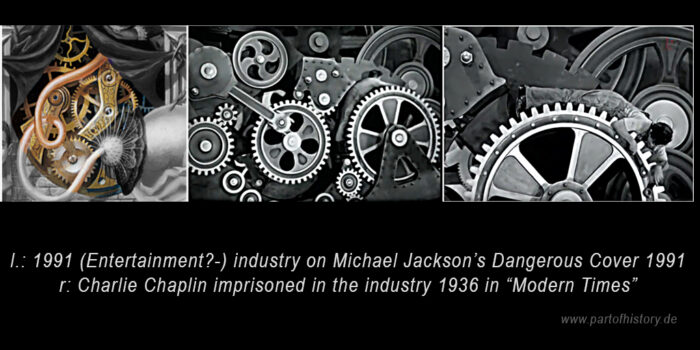
picture on the left: detail of Michael Jackson’s DANGEROUS album cover 1991. The other pictures depict Charles Chaplin in his movie „Modern Times“.
Michael Jackson and the Kid Jackie Coogan in Charles Chaplin’s movie „The Kid“
In the mid-1990s, Michael Jackson was working on a short film and photo session for his cover song SMILE. This song that Charles Chaplin had composed. The photos for the project show Michael dressed as Charlie Chaplin. In one photo session, he pays tribute to Chaplin’s 1921 movie titled „The Kid“. In this film, Chaplin seems to have made his own childhood the subject in 1921. A childhood that Chaplin had had to spend in the slums of London. In 1921, child star Jackie Coogan played alongside Chaplin in „The Kid“.
„For the next few hours, Michael educated me on Charlie Chaplin, and specifically his film The Kid, and about Jackie Coogan, the child actor who played opposite Chaplin in the film, and how Jackie’s experiences led to all of the laws that now exist protecting child performers.“
Steve Whitsitt, Michael Jacksons photographer for the photo session for the song SMILE. 12
„As a child star, Coogan earned an estimated $3 to 4 million ($44 to 59 million in 2021 dollars). When he turned 21 in October 1935, his fortune was believed to be well intact. […] Coogan soon discovered, though, that nearly the entire amount had been squandered by his mother and stepfather, Arthur Bernstein, on fur coats, diamonds and other jewelry, and expensive cars. […] Coogan sued them in 1938 […]
Jackie Coogan – Wikipedia
The legal battle focused attention on child actors and resulted in the 1939 enactment of the California Child Actor’s Bill, often referred to as the „Coogan Law“ or the „Coogan Act“. It required that a child actor’s employer set aside 15% of the earnings in a trust (called a Coogan account) and specified the actor’s schooling, work hours, and time off. […]„
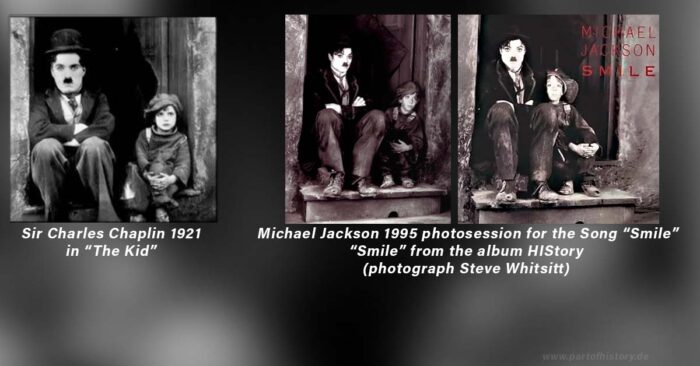
picture left: Sir Charles Chaplin as the tramp Charlie Chaplin in 1921 in „The Kid“ and in the middle and on the right Michael Jackson, photo session Steve Whitsitt for SMILE, 1994.
In 1997, Michael Jackson planned to release his own short film to accompany the song SMILE. Using technical effects, Michael Jackson wanted to produce an interpretation of Chaplin’s „The Kid“ side by side with images of Charles Chaplin. Unfortunately, nothing ever came out of this project, with which Michael Jackson had certainly wanted to draw attention to the exploitation of children in show business.
„Nevertheless, MJ began to shoot the video with a child supposed to play a kid. The idea of MJ was to being himself sent into some scenes of the movies from Chaplin, with the use of CGI. That was going too far for the Chaplin’s estate who didn’t want the seriousness of the Chaplin movies to be played, neither to give the Tramp another interpretation. Jackson wanted to dance with Chaplin […]. One must confess that Jackson was very incredibly good at playing the Tramp; and knew perfectly the art of pantomime he developed through his dance moves.“, Jackson being disguised in the character of the TRAMP.“
Los Angeles Times, 2009. 13
But on this album, entitled HIStory which is an autobiography in Michael Jackson’s own special way, Michael nevertheless ends the narrative about his life with a smile …
P. T. Barnum, the Manager on DANGEROUS
Fortunately, on the 1991 DANGEROUS album cover is Michael’s guardian angel close by. Barnum, symbol of countless, profit-oriented managers in Michael’s life, seems to be waiting already.
„Have you seen my childhood …?“
Michael Jackson in his song CHILDHOOD 1995, album HIStory. 14
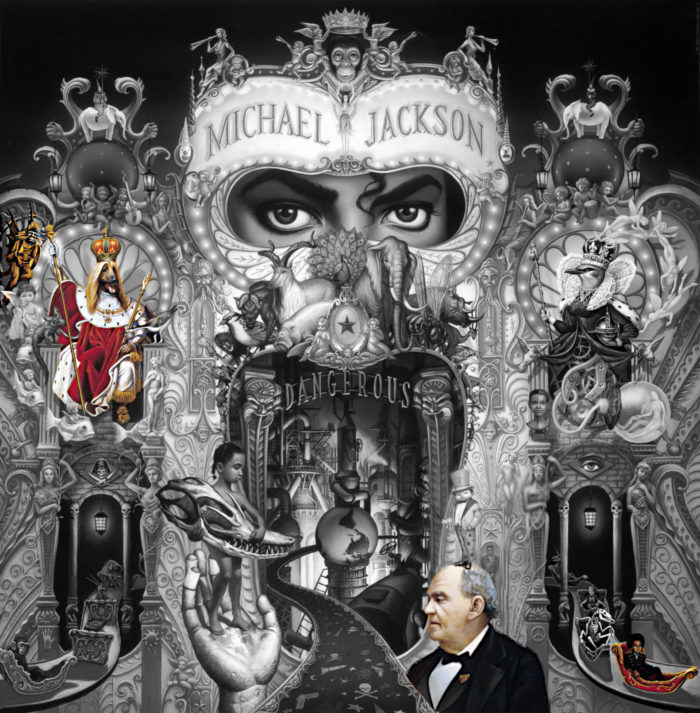
picture: Michael Jackson’s childhood happened in front of the eyes of the public – just like on the DANGEROUS cover in 1991.
Perhaps Michael Jackson allowed contact with other child stars such as Macaulay Culkin, Corey Feldman or Emmanuel Lewis not to share suffering, but to protect them from the dangers in the entertainment industry and to give them strength? The strength that Shirley Temple herself had given him.
And maybe Michael Jackson made room for another former Hollywood child star on the DANGEROUS album cover in 1991: Elizabeth Taylor. More on this in the following article:
Related articles:
Quellen
- Jackson, Michael, CHILDHOOD, 14.06.1995, CD HIStory-Past, Present and Future Book I, Sony Music
- Rabbi Boteach, Shmuley: A tragic icon reveals his soul in intimate conversation – The Michael Jackson Tapes, 25.09.2009, „SB: „So Macaulay Culkin doesn’t need to say to you, ‚I was on the set and this happened with my father.‘ You don’t even have to have conversations like that? MJ: „Oh yeah. There is this precious sweet little soul who is a baby, Macaulay Culkin, who is wondering, ‚How did I get caught up in all of this? I never asked to be an actor.‘ He always wanted out. You gotta watch that energy when he gets heavy on his father, man, it tears into him and that’s what happens, you know. Oh, but I saw it myself with him. [Michael screams] „Mac get in here!“ the screaming …“, Vanguard Press
- Macaulay Culkin, Interview 2018: „Macauley Culkin opens up about relationship with Michael Jackson: “It never struck me as odd. I never felt uncomfortable”, 2018.01.23., Furthermore, Culkin talks about his father: “We didn’t like each other,” he said. “He was a bad man. He was abusive, physically and mentally. I can show you all my scars if you want to. He was a bad dude.”, https://consequenceofsound.net/2018/01/macauley-culkin-opens-up-about-relationship-with-michael-jackson-it-never-struck-me-as-odd-i-never-felt-uncomfortable/
- Boteach, Rabbi, Shmuley: „A tragic icon reveals his soul in intimate conversation – The Michael Jackson Tapes“, 25.09.2009, Vanguard Press.
- Jackson, Michael: „Dancing the Dream – Angel of Light„, 1992/1993: „It’s hard to see angels, although I’ve stared at their pictures for hours. Some people can see them without pictures, and they tell interesting tales. Guardian angels are all female, for instance, which didn’t surprise me once I found out. A birth angel, recruited from the younger ranks, attends every baby when it appears, while another angel, older but not grim, helps the dying to leave this world without grief or pain. You can pray to the angels, and they will listen, but the best way to call them, I am told, is to laugh. Angels respond to delight, because that is what they’re made of. In fact, when people’s minds are clouded by anger or hatred, no angel can reach them.“, Doubleday an imprint of Transworld Publishers, London/Goldmann Verlag Bertelsmann
- Rabbi Boteach, Shmuley: „A tragic icon reveals his soul in intimate conversation – The Michael Jackson Tapes„, 25.09.2009, Vanguard Press
- Rabbi Boteach, Shmuley: „A tragic icon reveals his soul in intimate conversation – The Michael Jackson Tapes„, 25.09.2009, Vanguard Press
- Jackson, Michael, Dancing the Dream – Angel of Light, 1992/1993, „It’s hard to see angels, although I’ve stared at their pictures for hours. Some people can see them without pictures, and they tell interesting tales. Guardian angels are all female, for instance, which didn’t surprise me once I found out. A birth angel, recruited from the younger ranks, attends every baby when it appears, while another angel, older but not grim, helps the dying to leave this world without grief or pain. You can pray to the angels and they will listen, but the best way to call them, I am told, is to laugh. Angels respond to delight, because that is what they’re made of. In fact, when people’s minds are clouded by anger or hatred, no angel can reach them.“, Doubleday an imprint of Transworld Publishers, London/Goldmann Verlag Bertelsmann
- Boteach, Rabbi, Shmuley: „A tragic icon reveals his soul in intimate conversation – The Michael Jackson Tapes„, 25.09.2009, „MJ: He knows that, but he finds it hard to give you a compliment and that’s what made me into such a perfectionist trying to impress him …”, Vanguard Press. Kindle-Version, Kindle-Positionen1374-1377.
- Todd Gray, 2018, in Todd Gray: Michael Jackson’s official photographer, Todd Gray: Michael Jackson’s official photographer – National Portrait Gallery (npg.org.uk)
- Freedman, Russel, „Kids At Work – Lewis Hine“, 1994, page 5, 22, 72, 86 Clarion Books, New York, 1994.
- Whitsitt, Steve, Michael Jacksons photographer.
- Los Angeles Time, 2009„, articles.latimes.com/2009/dec…pus9-2009dec09
- Jackson, Michael, CHILDHOOD, 14.06.1995, CD HIStory-Past, Present and Future Book I, Sony Music